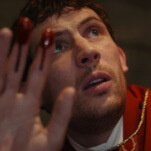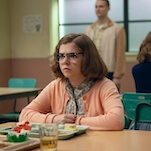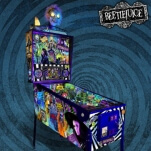How Chainsaw Man – The Movie Draws On And Transforms Classic Myth

Tatsuya Yoshihara and MAPPA’s Chainsaw Man – The Movie: Reze Arc is a mostly one-to-one take on its manga source material. The movie does little to possibly alter what made Tatsuki Fujimoto’s original story so popular. While a few moments of strong tonal choices in color and lighting highlight the animators’ additive contributions, other changes largely serve to draw out the film’s climactic action sequences, which only forestall the prescribed development of characters, world building, and plot. But there’s one addition that, while not transformative, is truly notable: a painting.
In the school that Reze lures Denji through with promises of normal teenage experiences—like sitting at a desk to answer questions or going skinny dipping with the manic pixie dream girl completely obsessed with him—hangs French Rococo painter François Boucher’s 1743 painting Daphnis and Chloe. It depicts the titular lovers, who grew up abandoned on the island Lesbos to face many tribulations and fall in love, enjoying their pastoral idyll together. It suggests the vision Reze offers Denji, that they could perhaps find love together after being similarly dispossessed as children, its pastoral setting invoking the country mice in Aesop’s fable. The framed framing device contextualizes this moment of Chainsaw Man in the classical tradition in a way that one might imagine Fujimoto himself envious of.
Chainsaw Man’s classical allusions are many. Angel Devil, who also makes his debut in the Reze arc as a lazy and attractive androgyne, is based on the red haired, white-winged depiction of Lucifer in Alexandre Cabanel’s The Fallen Angel. In a late manga chapter, Gustave Doré’s engraving of Satan falling to Hell in Paradise Lost is prominently featured in Makima’s apartment. Mappa’s serial adaptation, released three years ago, would add another Doré engraving (a scene of demons hunting sinners from Dante’s Inferno) to her office. The manga is steeped in the classics, inheriting even their structure as present in Reze Arc’s tragedy.
And there’s another myth that emphasizes the importance of Reze and her teen hypersexuality in the movie and manga, one that, alongside its 16th-century renditions, shapes the bedrock of Reze Arc: Venus and Adonis.






































